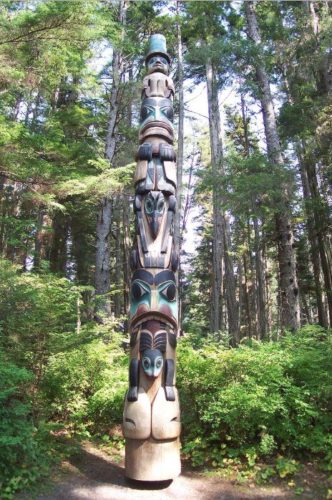The Wild Hunt . In early October 2018, Alaskan Governor Bill Walker declared a linguistic emergency. Alaska has 20 indigenous Native American languages that may all become extinct within a hundred years, unless people do something to preserve them. Linguists define a language as extinct when no living person can speak that language. The National Indian Educational Association reports that only 20 Native languages are expected to survive to 2050. Not only is the world losing its genetic diversity, but the world is also losing its linguistic diversity. The UN has named 2019 as the “International Year of Indigenous Languages.”
2019 International Year of Indigenous Languages Source: UNESCO
Linguists define “a native speaker” of a language as someone who learns a language in childhood as their mother tongue. When the number of a language’s native speakers decreases, it become endangered. When the last native speaker of a language dies, so does that language. This is occurring globally. According to Wikipedia, linguists estimate that people speak between 6,000 and 7,000 languages. “The Cambridge Handbook of Endangered Languages” estimates that “between 50 percent and 90 percent of them will have become extinct by the year 2100.” More and more people are speaking fewer and fewer languages.
Some people have argued that the loss of linguistic diversity is not bad. They argue that it could make travel and communication easier. They also argue that language death is part of cultural evolution. While some languages die, more widely spoken languages adopt and adapt some of their words and concepts.

Native Alaskan Totem Pole at Sitka National Historical Park. Photo by Robert A. Estremo [Wikimedia Commons]
US policy toward Native languages
The US government attempted to suppress Native American languages and cultures until the 1930s. It used the law, genocide and forced removal to do so. The Post WWII civil rights movement empowered Native American demands for self-determination. Only in 1990 did the US Congress pass the Native American Languages Act. This law states that Native Americans have a right to linguistic self-determination.
Rosalyn R. LaPier has written, “Languages carry deep cultural knowledge and insights.” She continued, “Embedded in indigenous languages, in particular, is knowledge about ecosystems, conservation methods, plant life, animal behavior and many other aspects of the natural world.”
When Blackfoot elders from Montana and Canada examined Blackfoot objects stored in museums, they noted that the museum had labeled most plant specimens as “herbs.” The English word “herb” tends to be associated primarily with botany and cooking. The closest Blackfoot word to “herb” has a meaning in English of “a tool that doctors use.”
An Ojibway elder from the Upper Midwest said, “Once a language is gone, the traditional knowledge it carries also gets erased from society.”
Types of language death
The Langfocus channel on YouTube by linguist Paul Jorgensen discussed language death and extinction.
That video described different types of language death. One type, “gradual language death” occurs as a power struggle between two languages that occurs as follows. The speakers of “language X” have higher status and more power than those of “language Y.” After X-speakers come into sustained contact with Y-speakers, Y-speakers will become bilingual. X-speakers will not. As adult Y-speakers adopt more of X-language and its culture, they become a new elite. Later, the children of Y-speakers will start to learn the X-language rather than Y-language. Gradually, people will speak Y-language less well, and the vocabulary of Y-language will contract. The number of native Y-speakers will decrease. The language will disappear in formal contexts but remain in more casual settings. Gradual language death describes a process consistent with assimilation and colonialism.
“Bottom to top language death” mirrors gradual language death. In this case, the masses cease speaking the language. The elites maintain the language for religious or ceremonial purposes. Medieval and modern Latin exemplifies this type of language death. The masses began to speak the evolving Romance languages. Latin remained the language of the educated. Hebrew also had suffered a bottom to top language death. The masses of Ashkenazi Jews spoke Yiddish in their daily life. They used Hebrew only for religious purposes.
Language revitalization
While some languages have died, people are trying to revive extinct and endangered languages. Israeli Jews revived Hebrew after WWII, as part of recovery after genocide.
Native Americans and other groups are making efforts to revive threatened and dead languages. The Ojibway nation has established language immersion schools for children to learn the language and culture.
The Wampanoag tribe/nation of New England developed the Wôpanâak Language Reclamation Project. That project has credentialed two Wampanoag linguists and 15 certified language teachers.
By the start of the 20th Century, the Shinnecock of Long Island had maintained parts of their culture, but had lost their language. Only some isolated words remained. In the 1980s, Tina Tarrrant gave her children Shinnecock names based on those few surviving words.

Shinnecock Nation Cultural Center and Museum in Southampton, New York. Photo Credit: w:en:Americasroof [Wikimedia Commons]
The loss of her ancestral language left Tarrant feeling like she didn’t know her own culture. She has regrets that no one grew up knowing the Shinnecock language. Still she said ““It’s OK that we weren’t taught this growing up.” She continued, “This is something that we’re bringing back, and we need to embrace [it].”
The Wild Hunt is not responsible for links to external content.
To join a conversation on this post:
Visit our The Wild Hunt subreddit! Point your favorite browser to https://www.reddit.com/r/The_Wild_Hunt_News/, then click “JOIN”. Make sure to click the bell, too, to be notified of new articles posted to our subreddit.